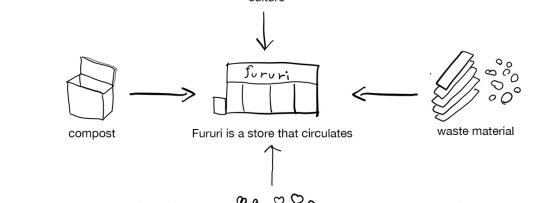I opened a design office 7 years ago in 2013. The office was named “kusukusu” in the hope that people involved in the construction, store management, and other aspects of our business would smile. But if we broaden our perspective a little bit, it’s not just people who are involved in our business. I think it is good that kindness will spread to the natural environment and to the earth if we think more about it.
A smile comes from fun and joy. And you can see it for the first time in relation to people or something. In other words, when a smile is born in one circle, it spreads more and more. For example, let’s start with my job “Design”.
The idea came from the idea of being kind to the earth and bringing smiles to people, and when composts are placed in cities, the design of “Compost x Community” where people gather comes to mind. People who bring home kitchen garbage or bring home the fertilizer ……。 At first, the interaction may be minimal. But as you get to know each other and smile a little bit through your greetings, the circle of community grows bigger and bigger. The important thing is to take it easy. Rather than having a difficult face because of someone’s patience, the circle is linked by forming a community where people can help each other and smile. Beyond that, there may be a very powerful resource cycle and a cycle of human thought.
What will become of a circular community? I have several project initiatives that I think can be roughly divided into two: “CST (Capability share type)” where initiatives from different locations lend features, and “ABT (ability building type)” where multiple capabilities converge in one place.
First of all, “CST (Capability share type)”. This is a shared capability system. From now on, the number of vacant houses and idle land where no one uses them will increase. What would happen if the communities that operate plant factories and farms on unused land and create compost-centered communities cooperated?
For example, Hayama is focusing on composting, and Kamakura has a plant factory. The alternative is to grow vegetables in Kamakura using the fertilizer made in Hayama, and then return the vegetable chips grown in Kamakura to Hayama. If local governments close to each other can cooperate, there will be a community of residents beyond local governments.
This can be further reduced to a “ABT (ability building type)”. Let’s assume that the second and third floors of a 5-story building are vacant. Up until now, we’ve been talking about lowering rent and including residents …… but let’s put a plant factory there. The first floor is a cafe and the fourth and fifth floors are a residential area. This creates a cycle in which kitchen garbage generated on the first floor, the fourth floor, and the fifth floor is sent to the plant factory, and harvested vegetables are sent to the cafe and residential area.
The great thing about the building is that it can incorporate a combination of low environmental impact initiatives such as producing electricity from sunlight and filtering and circulating water. For areas that require specialized skills, we can expect sustainable operation by having companies that excel in the field participate. Because this project can create relationships between different industries, it can also serve as a hub where different circles of (1) tenants and other tenants of buildings, (2) customers and other users of buildings, and (3) project participants intersect.
If such efforts increase, people will become more affluent, technological progress will be made, and a society that is friendly to nature will grow.

